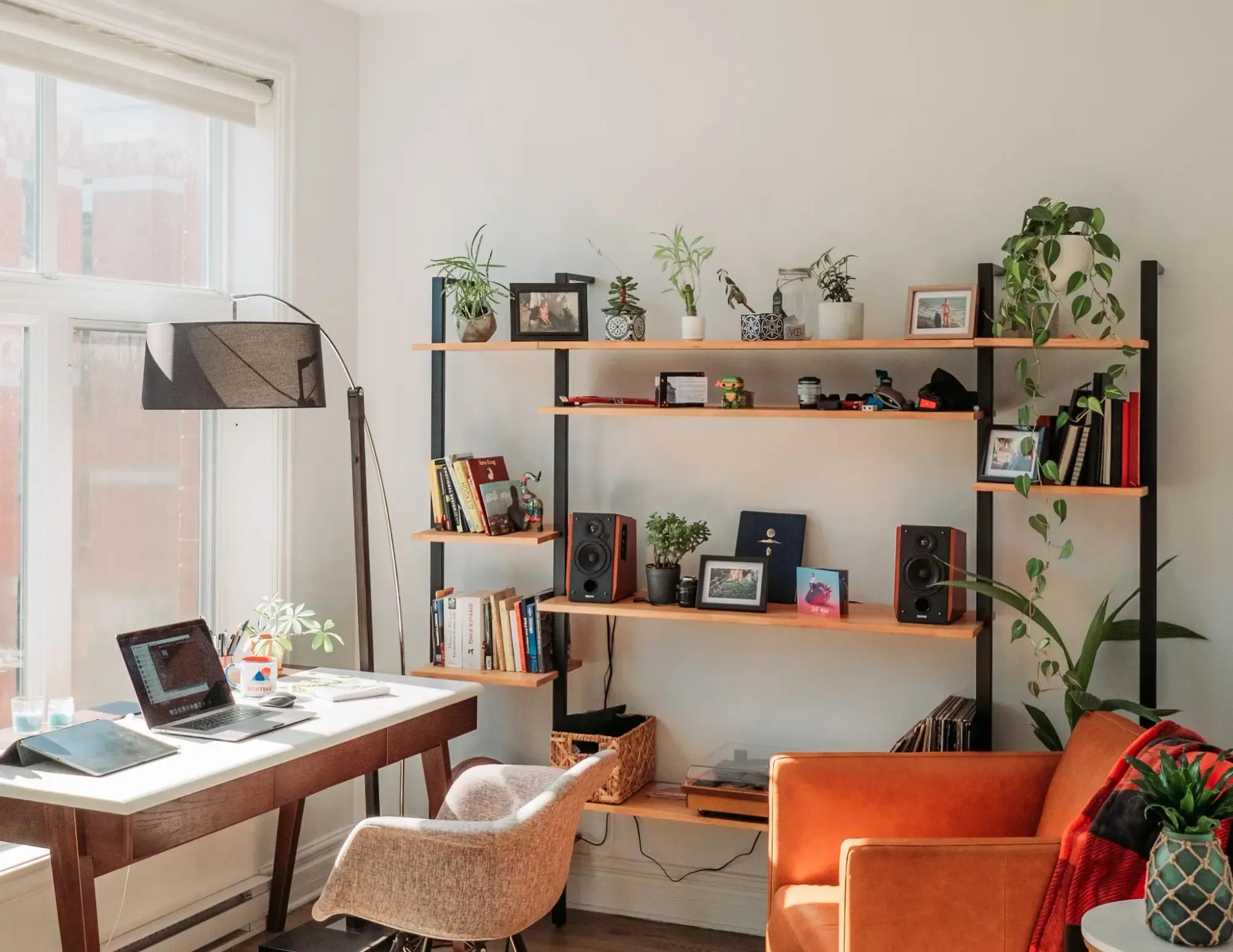What is an Étagère?
Meet the chic French shelf that's been turning walls into wow-factors since the 18th century. Display, divide, and conquer your space with open-armed elegance!

I first encountered an étagère in my grandmother's dining room. It wasn't until years later that I learned the proper name for this open-shelved piece of furniture and discovered its rich history and versatile applications in interior design.
An étagère is a unique and versatile piece of furniture that adds both style and functionality to any space. With its open shelves and elegant design, it offers a perfect blend of form and function. In this article, we will delve into the concept of an étagère, its design elements, functionality, and some key considerations when buying one.
Understanding the Concept of an Étagère
An étagère, pronounced ay-ta-zhair, is a piece of furniture consisting of open shelves for displaying objects. The term originates from the French word "étager," meaning "to arrange on different levels." Étagères emerged in 18th-century France as a response to the growing desire among the aristocracy to showcase their collections of curiosities and objets d'art.
Étagères are versatile pieces of furniture that can be used in various rooms of the house, from the living room to the bathroom. They provide a stylish way to display and organize items while adding a touch of elegance to any space. The open design of an étagère allows light to flow through the shelves, creating a sense of airiness and openness in the room.
Historical Context
The popularity of étagères soared during the Victorian era, a time marked by the rise of the middle class and an increased interest in home decor. These pieces allowed people to display their collectibles, books, and other prized possessions, serving as both functional storage and a reflection of the owner's tastes and interests.
As manufacturing techniques improved and styles evolved, étagères became more accessible to the general public. They were produced in a variety of designs to suit different tastes and interior preferences, from ornate, carved wooden pieces to sleek, metal constructions.
Differentiating Étagère from Other Furniture
What sets an étagère apart from other furniture pieces is its characteristic open-shelf design. Unlike bookcases or cabinets with closed doors, étagères offer a more visually appealing and accessible way to showcase and organize your belongings. They often feature decorative details like scrollwork, ornate patterns, and intricate carvings.

Another distinguishing feature of étagères is their ability to create visual interest in a room. By displaying items on different levels and incorporating a mix of textures and materials, an étagère can serve as a focal point that draws the eye and adds personality to the space.
Étagère vs. Bookcase
While similar, étagères and bookcases have distinct differences:
- Openness: Étagères are open on all sides, while bookcases typically have a closed back.
- Weight capacity: Bookcases are designed to hold heavier items like books, while étagères are better suited for lighter objects.
- Depth: Étagère shelves are usually shallower than bookcase shelves.
- Decorative focus: Étagères are primarily for display, whereas bookcases prioritize storage.
The Design Elements of an Étagère
The design of an étagère encompasses various elements that contribute to its overall aesthetic and functionality. The choice of materials and the styles and shapes available play a significant role in determining the perfect étagère for your space.
Materials Used in Étagère Construction
Étagères can be crafted from a variety of materials, each with its own unique charm:
- Wood: Particularly hardwoods like oak, mahogany, or walnut, lend a classic and timeless appeal.
- Metal: Often made from wrought iron or brass, metal étagères offer a more contemporary and industrial look.
- Glass: Glass étagères create a sense of lightness and elegance, ideal for smaller rooms.
Styles and Shapes of Étagères
Étagères come in a wide range of styles and shapes to suit different tastes and interior designs:
- Traditional: Ornate designs with intricate details, often featuring carved wood or decorative metalwork.
- Modern: Sleek structures with clean lines, typically made of metal and glass.
- Industrial: Utilitarian designs often featuring metal frames and wood shelves.
- Ladder-style: Leaning designs that offer a unique, space-saving solution.
Types of Étagères
Étagères come in various styles to suit different interior design preferences:
Traditional Étagères - These often feature ornate woodwork, curved lines, and decorative finials. They're well-suited to classic or vintage-inspired interiors.
Modern Étagères - Characterized by clean lines and minimalist design, modern étagères often incorporate materials like metal and glass for a contemporary look.
Industrial Étagères - Typically made of metal with a rough or distressed finish, these étagères complement industrial or urban-style decor.
Corner Étagères - Designed to fit into corners, these space-saving pieces are ideal for smaller rooms or awkward spaces.
The Functionality and Versatility of an Étagère
One of the major advantages of an étagère is its versatility and ability to serve multiple purposes.
Uses of an Étagère in Home Decor
An étagère can be a fantastic addition to any room in your home:
- Living Room: Use it to display books, photographs, and decorative items.
- Kitchen: House cookbooks, jars, and spices.
- Bathroom: Hold towels, toiletries, and plants to create a spa-like atmosphere.
- Home Office: Serve as a stylish storage solution for files, office supplies, and personal mementos.
They can be used across rooms for different functions:
- Display: Showcase collectibles, artwork, or family photos.
- Room divider: Use a tall étagère to create visual separation in an open floor plan.
- Storage: Utilize the shelves for books, plants, or decorative storage boxes.
- Focal point: A well-styled étagère can serve as a room's centerpiece.
Making the Most of an Étagère in Small Spaces
If you're dealing with limited space, an étagère can be your saving grace:
- Opt for a slim and tall étagère to maximize vertical space.
- Utilize the lower shelves for storage baskets or boxes to keep items neatly organized.
- In a small entryway, use an étagère with hooks or pegs to hang coats, bags, and keys.
- In a compact bedroom, an étagère can function as a bedside table with extra storage.
Styling an Étagère
When arranging items on an étagère, consider the following tips:
- Vary heights and sizes of objects for visual interest.
- Group items in odd numbers for a balanced look.
- Incorporate different textures to add depth.
- Use the top shelf for taller items or trailing plants.
- Leave some empty space to avoid a cluttered appearance.
Buying an Étagère: What to Consider
Before making a purchase, there are a few essential factors to consider to ensure you choose the right étagère for your space.
Choosing the Right Étagère for Your Space
- Assess your space and measure the area where you intend to place the étagère.
- Think about the style and material that will complement your existing decor.
- Consider the functionality it will serve (displaying decorative items, storing books, etc.).
- Determine the number and spacing of shelves needed to accommodate your belongings.
- Consider the weight-bearing capacity of the étagère to ensure it can safely support your items.
Care and Maintenance of Your Étagère
To keep your étagère looking its best:
- Regular dusting and wiping with a clean, soft cloth are usually sufficient.
- Avoid using harsh chemicals or abrasive materials that may damage the finish.
- Consider the placement of your étagère to protect it from direct sunlight and fluctuating humidity.
- Periodically check and tighten any loose screws or fittings.
Final Thoughts
Étagères offer a unique blend of functionality and aesthetics in interior design. Whether you're looking to display a cherished collection, add storage to a small space, or simply incorporate a touch of elegance to your decor, an étagère can be an excellent choice. From the ornate designs of the Victorian era to sleek, modern interpretations, these versatile pieces continue to find their place in homes around the world.
Check out étagères on Spoken and experience the joy of shopping smarter, not harder, for your home.
Quick facts
What is the meaning of etagere?
An etagere is a piece of furniture with open shelves used for displaying ornaments, plants, or other decorative items. It is often lightweight and designed to showcase objects.
What is the difference between an etagere and a bookcase?
An etagere is typically open and used for displaying decor, while a bookcase is enclosed and designed to hold books. Etagères are often more decorative, with an emphasis on style and display.
How do you pronounce etagere?
Etagere is pronounced "ay-tah-zhair," with a soft French pronunciation.
What is an etagere in French?
In French, "etagere" simply means "shelf" or "set of shelves." It refers to a piece of furniture designed for storage or display.

Dane Hurtubise
Co-founder & CEO of Spoken
Dane Hurtubise is the Co-founder & CEO of Spoken. He has led two venture-backed companies and is a two-time Y Combinator alum. Prior to Spoken, Dane sold his previous company, Parklet, to Greenhouse Software where he served as VP of Platform and Partnerships. An avid runner, cyclist, and Pilates enthusiast, Dane holds a BS in Electrical and Computer Engineering from the University of Texas at Austin.
Read more

